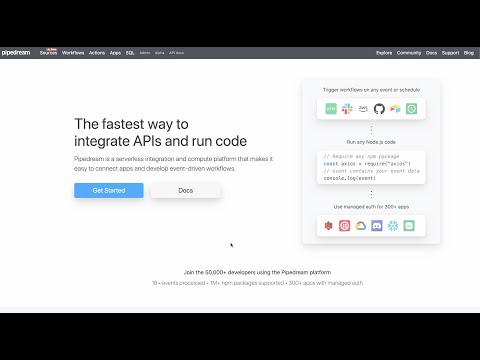What do you want to automate
with PagerDuty and Google Vertex AI?
Prompt, edit and deploy AI agents that connect to PagerDuty, Google Vertex AI and 3,000+ other apps in seconds.
Trusted by 1,000,000+ developers from startups to Fortune 500 companies
Popular Ways to Connect PagerDuty with Google Vertex AI#
Popular PagerDuty and Google Vertex AI Actions#
Examines an image or video following given instructions. Results will contain the analysis findings. See the documentation
Find the user on call for a specific schedule. See the docs here
Analyzes a specified text for its underlying sentiment. See the documentation
Groups a provided text into predefined categories. See the documentation
Overview of PagerDuty#
The PagerDuty API offers a powerful interface to automate your digital operations management. By leveraging its capabilities on Pipedream, you can create workflows that respond to incidents, automate alerts, and synchronize incident data across various platforms. PagerDuty's API enables you to manage services, teams, and incidents, ensuring that your systems remain operational and that the right people are notified at the right time.
Connect PagerDuty#
import { axios } from "@pipedream/platform"
export default defineComponent({
props: {
pagerduty: {
type: "app",
app: "pagerduty",
}
},
async run({steps, $}) {
return await axios($, {
url: `https://api.pagerduty.com/users/me`,
headers: {
Authorization: `Bearer ${this.pagerduty.$auth.oauth_access_token}`,
"Accept": `application/vnd.pagerduty+json;version=2`,
},
})
},
})
Overview of Google Vertex AI#
With the Google Vertex AI API, you can tap into a robust suite of AI tools offered by Google Cloud to build, deploy, and scale machine learning models. Whether you're processing data, training custom models, or using pre-trained ones, Vertex AI provides a unified platform for AI development. In Pipedream, you can create serverless workflows that interact with Vertex AI, allowing you to automate tasks like model training, prediction, and resource management without provisioning your own infrastructure.
Connect Google Vertex AI#
import { axios } from "@pipedream/platform"
export default defineComponent({
props: {
google_vertex_ai: {
type: "app",
app: "google_vertex_ai",
}
},
async run({steps, $}) {
return await axios($, {
url: `https://www.googleapis.com/oauth2/v1/userinfo`,
headers: {
Authorization: `Bearer ${this.google_vertex_ai.$auth.oauth_access_token}`,
},
})
},
})
Related Videos#
